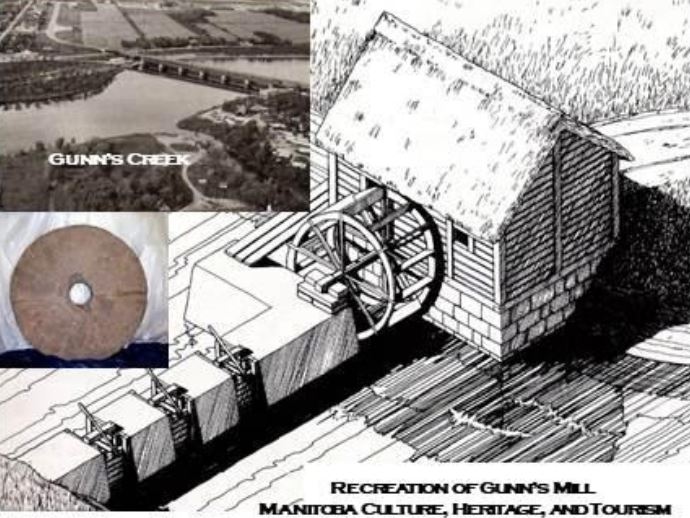Members of the Gunn family were important figures in early Manitoba. Donald and his son John played important roles in religion, politics, education, science, and enterprise.
Built in the 1850’s, Gunn’s flourmill was a local center of industry and commerce. The power for this flourmill came from the spring-thaw waters that flowed down Gunn’s Creek to the Red River.
John Gunn built the mill on lot 167 near the creek’s junction with the Red River. The two-storey mill building measured 24 x 34 feet and had a thatch roof. The second floor contained the stones which ground the flour and the sundry bins for the storage of wheat. There were no glazed windows on the mill. The light needed for work came through the open door and unchinked logs. Almost every wheel and spindle for the mill was manufactured by local artisans. Self-trained wheelwright and joiner, John Gunn, made many of the wheels out of native oak. The water wheel measured 16 feet in diameter.

The millstones were cut from native granite located on the east side of Lake Winnipeg. These massive stones measured five feet in diameter, were eight inches thick, and had to be transported by York Boat to the site of the mill. The only fault with the millstones was that only one could be used at a time. The first time both were used simultaneously, it was described as shaking like an earthquake and the entire mill almost collapsed.
When the mill was in operation, it was a formidable industry. During flood season, the mill operated both day and night. However, by the 1870s the mill became obsolete with the introduction of new steam-powered mills.
The St. Clements Heritage Advisory Committee has discovered and restored one of the old millstones used in Gunn’s Mill. This millstone will be displayed with a descriptive plaque on the site of the old mill, which is currently located on the grounds of the newly constructed River Creek Estates apartment complexes.
Gunn’s Mill geocache site is located near Lockport, Manitoba, Canada at N 50º 04.868´ latitude and W 96º 56.026´ longitude. If you find the geocache and scan the QR code inside of it, it brings you here to learn more. Watch all of our videos on our YouTube Channel. Other heritage content can be found on our Red River North Heritage Youtube channel.
Transcription:
At this picturesque creek in the woods of Little Britain, a cultured and enterprising Scotsman made his home in the early 19th century.
In his youth, Donald Gunn left the treeless lands of Caithness, in the north of Scotland, to work for the Hudson’s Bay Company. He spent ten years with the company at posts in the far north of modern Manitoba and Ontario.
In 1823, Gunn settled onto a farm in the Red River colony. There, he became a pillar for Manitoba’s early Presbyterians.
He taught school, and helped set up a building for organized church activity. He also dabbled in scientific pursuits, acting as a correspondent with, and collector for the Smithsonian Institute in Washington.
Donald’s son, John, set up the mill along the creek that bears their clan name. They built almost the entirety of it with local mechanical skill and supplies. A few parts came from Missouri, and the millstone itself was cut from granite on Lake Winnipeg’s east side.
The mill operated in the 1850s, 60s, and 70s.
In his later years, Donald Gunn served in prominent political positions. During the Red River Rebellion, he became a delegate for St. Andrews to the Convention of Forty.
After confederation, he served on the legislative council of the province for five years. The legislative council was the now-abolished upper house of the Manitoba legislature, equivalent to the federal senate.
Gunn’s most lasting contribution to Manitoba history was quite literally history. His name was numbered among those of Manitoba’s first historians, with the posthumous publication of his History of Manitoba.